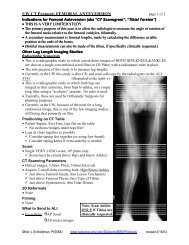Ankle and Foot 47 - Department of Radiology - University of ...
Ankle and Foot 47 - Department of Radiology - University of ...
Ankle and Foot 47 - Department of Radiology - University of ...
You also want an ePaper? Increase the reach of your titles
YUMPU automatically turns print PDFs into web optimized ePapers that Google loves.
2306 VII Imaging <strong>of</strong> the Musculoskeletal System<br />
A<br />
B<br />
D<br />
C<br />
E<br />
Figure <strong>47</strong>-109. Fracture <strong>of</strong> the lateral sesamoid in a 34-year-old who complained <strong>of</strong> localized pain plantar <strong>and</strong> lateral to the first metatarsal<br />
head, made worse with weight bearing <strong>and</strong> extension <strong>of</strong> the great toe, for 1.5 years before the diagnosis was made. Anteroposterior (A), oblique<br />
(B), <strong>and</strong> sesamoid (C) radiographs all clearly show the transverse split across the lateral sesamoid <strong>of</strong> the great toe. A bipartite lateral sesamoid is<br />
an uncommon variant, present in only 1% <strong>of</strong> the population, <strong>and</strong> when symptomatic should be interpreted as a fracture. Short-axis T1-weighted<br />
(D) <strong>and</strong> inversion recovery (E) images through the marker (m) indicating the site <strong>of</strong> maximum pain show normal bone marrow signal in the medial<br />
sesamoid (white arrow) <strong>and</strong> bone marrow edema in the lateral sesamoid (black arrow).<br />
medicine bone scan could be obtained if confirmation is<br />
necessary.<br />
Fractures <strong>of</strong> the medial sesamoid are more difficult to<br />
diagnose radiographically because this sesamoid is not<br />
infrequently multipartite in normal people. Here radiographs<br />
are <strong>of</strong> limited value, <strong>and</strong> more sensitive imaging<br />
modalities are <strong>of</strong>ten required. Although MRI can demonstrate<br />
abnormal marrow signal in the sesamoids, owing to<br />
the small size <strong>of</strong> these bones this may be present on only<br />
a single slice, <strong>and</strong> all imaging planes should be carefully<br />
scrutinized. Short-axis images are particularly helpful in<br />
comparing the marrow signal from the medial <strong>and</strong> lateral<br />
sesamoids side-by-side (Fig. <strong>47</strong>-110). The imaging <strong>of</strong> sesamoiditis<br />
is one <strong>of</strong> the few instances when we recommend a<br />
nuclear medicine bone scan over an MRI. In particular, the<br />
both-feet-on-the-detector view is extremely effective for<br />
localizing abnormal radiotracer uptake to one <strong>of</strong> the sesamoids<br />
(see Fig. <strong>47</strong>-110C).<br />
Ch0<strong>47</strong>-A05375.indd 2306<br />
9/9/2008 5:36:08 PM
















